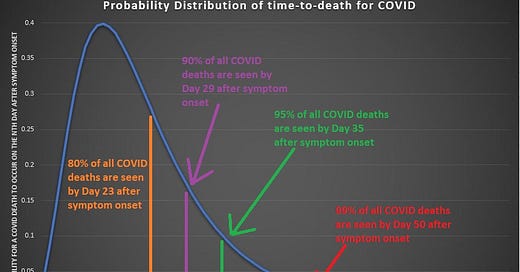Back in early February of 2020, the Diamond Princess Cruise ship sat quarantined in harbor in Japan. There were 3,711 people aboard, but in late January, someone carrying COVID had boarded for a while before departing.
By the end of the first half of February, several hundred passengers had been infected with COVID. The final evacuation report revealed 696 total confirmed COVID cases, and the very best estimate on the final death count is 7 — though other final estimates exist.
The reason that 7 is the best number is that it is the one which matches the evolution of time-to-death for COVID. Here is a distribution that shows when deaths occur:
As you can see from the way that COVID deaths spread out across time after symptom onset, 95% of all COVID deaths will have been seen by Day 35 after symptom onset (and 99% will have occurred by Day 50).
Here is a screenshot of the World Health Organization Situation Report #72, posted on April Fool’s Day, showing 7 total deaths of passengers who had become infected on the ship:
The number of infections showing here is 712, which contradicts the final evacuation report — where they only counted 696 confirmed COVID cases. Japan had released highly-detailed case data by age group before the final evacuations had taken place, and their numbers included the first 89% of all infections (Japan data at lower left):
[click image to enlarge]
Because only elderly died, you can get an elderly infection fatality rate (IFR) for COVID from this “natural experiment” where a cruise ship served as a veritable petri dish. The median age on the ship was 65, making half of everyone elderly.
That elderly IFR for COVID is 1.53%.
Because the CDC kept track of all elderly who died of COVID by Sep 2021, and also of the overall infections and deaths, you can even use an elderly IFR to “back-calculate” a general population (all-ages) IFR for a nation with similar age-structure as the USA. Here is how you do it:
When the elderly IFR from the Diamond Princess is used in order to generate an all-age IFR for COVID — by dividing 1.53 by 6.2 — then it comes out to 0.25%, which is just like the IFR from the pre-vaccine death data from UK Technical Briefing #5:
[click image to enlarge]
In other words, the data from the Diamond Princess and the data from the UK corroborate (mutually-validate) each other, leading to a convergence on the all-ages IFR of early COVID that is approximately 0.22 to 0.25%.
It’s important to note this cross-validation of low IFR estimates because COVID models are becoming notorious for using IFR estimates much higher — even more than 3 times higher than what the really good evidence (Diamond Princess and UK Technical Briefing #5) suggests.
Reference
[Diamond Princess breakdown of cases by age] — National Institute of Infectious Diseases in Japan. Available from: https://www.niid.go.jp/niid/en/2019-ncov-e/9417-covid-dp-fe-02.html
[WHO COVID-19 Situation Report #72 on 1 Apr 2020 showing 7 Diamond Princess deaths 46 days after all passenger infections had occurred] — WHO. https://www.who.int/docs/default-source/coronaviruse/situation-reports/20200401-sitrep-72-covid-19.pdf
[Diamond Princess final evacuation report of 769 possible COVID with 696 confirmed] — Anan H, Kondo H, Takeuchi I, Nakamori T, Ikeda Y, Akasaka O, Koido Y. Medical Transport for 769 COVID-19 Patients on a Cruise Ship by Japan Disaster Medical Assistance Team. Disaster Med Public Health Prep. 2020 Dec;14(6):e47-e50. doi: 10.1017/dmp.2020.187. Epub 2020 Jun 5. PMID: 32498735; PMCID: PMC7298096. https://www.ncbi.nlm.nih.gov/pmc/articles/PMC7298096/
[median age on Diamond Princess = 65 years old] — Jon C Emery Timothy W Russell Yang Liu Joel Hellewell Carl AB Pearson CMMID COVID-19 Working Group Gwenan M Knight Rosalind M Eggo Adam J Kucharski Sebastian Funk Stefan Flasche Rein MGJ Houben. (2020). The contribution of asymptomatic SARS-CoV-2 infections to transmission on the Diamond Princess cruise ship. eLife 9:e58699. https://doi.org/10.7554/eLife.58699
[CDC page showing that the IFR for elderly is 6.2 times the IFR for the general (all ages) population overall] — CDC. https://www.cdc.gov/coronavirus/2019-ncov/cases-updates/burden.html
[As of 19 Jan 2021, from 52,000 COVID infections with Alpha (SGTF) variant, there were 104 deaths by Day 28 (corrected to 117 total deaths, by using upper bound estimates from Linton et. al.)] — Page 3. Epidemiological findings. UK Technical Briefing #5. https://www.gov.uk/government/publications/investigation-of-novel-sars-cov-2-variant-variant-of-concern-20201201
[“Time-to-death” model for COVID; using the 95% UB of both the mean and SD of the lognormal model that fit the actual deaths best] — Linton NM, Kobayashi T, Yang Y, et al. Incubation Period and Other Epidemiological Characteristics of 2019 Novel Coronavirus Infections with Right Truncation: A Statistical Analysis of Publicly Available Case Data. Journal of Clinical Medicine. 2020 Feb;9(2). DOI: 10.3390/jcm9020538. PMID: 32079150; PMCID: PMC7074197. https://www.ncbi.nlm.nih.gov/pmc/articles/PMC7074197/
[Imperial College model using an evidence-contradicting IFR of 0.9%] — Imperial College COVID-19 Response Team. Report 9: Impact of non-pharmaceutical interventions (NPIs) to reduce COVID-19 mortality and healthcare demand. https://www.imperial.ac.uk/media/imperial-college/medicine/sph/ide/gida-fellowships/Imperial-College-COVID19-NPI-modelling-16-03-2020.pdf
[recent COVID model which requires an IFR of at least 0.9% again, just like the Imperial College one did] — Two Years of U.S. COVID-19 Vaccines Have Prevented Millions of Hospitalizations and Deaths. https://doi.org/10.26099/whsf-fp90








